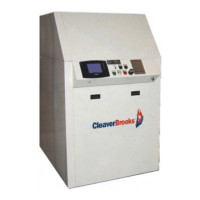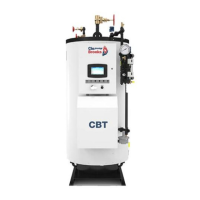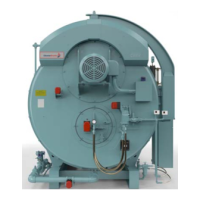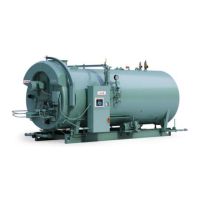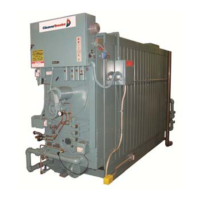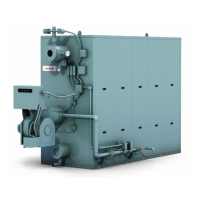CB FALCON
85 750-265
Adding Stages
The internal algorithms that generate AddStageRequests are
called Add-stage methods. All methods work by observing
various criteria such as the Firing stages, the commanded rate,
or setpoint error.
Add-stage Methods
Error threshold For error threshold staging, a stage is added
when the error becomes excessive based on degrees away
from setpoint, and time.
Add-stage condition:
• The modulating burner(s) is at its (their) maximum position
per the rate allocation rules,
• The operating point is below the setpoint by an amount
greater than or equal to LL - Add-stage error threshold
When the Add-stage condition is false then
AddStageDetectTimerN is set to zero. (If the condition is true
then AddStageDetectTimerN is not zeroed and thus allowed to
run.) If this timer reaches or exceeds LL- Add-stage detection
timeN then AddStageRequestN is true.
Rate threshold For rate based staging, a stage is added
based on the rate of the modulating stage.
Add-stage condition The modulating burner is at a rate that is
at or above the rate which is calculated by adding the LL - Add-
stage rate offset to the maximum position per the rate
allocation rules.
Examples:
rate offset = 20% The add-stage condition will occur if the
modulating stage is 20% above base load for unlimited allo-
cations, or, if limited, when there is 20% more rate to
distribute than can be absorbed by firing the stages at base
load.
rate offset = -20% The add-stage condition will be as
described just above, but the threshold is now 20% below
the modulating stage's base load rate.
To support this, the current Rate Allocation method asks for the
current “Overflow rate” - see the Rate Allocator section.
Dropping Stages
The internal algorithms that generate DropStageRequests are
called Drop-stage methods. One or two methods may be active
at any time. If two are active then their requests are OR'd
together. All methods work by observing various criteria such
as the Firing stages, the commanded rate, or Setpoint.
Dropping Stages Parameters:
Table 43. Stager Parameters.
Parameter Comment
LL - Add-stage interstage delay mm:ss
This specifies the minimum time that the Stager waits after adding one stage before adding
another stage or dropping a stage.
LL -Drop-stage interstage delay mm:ss
This parameter specifies the minimum time that the Stager waits after dropping one stage
before dropping another stage or adding a stage.
Table 44. Adding Stages Parameters.
Parameter Comment
LL - Add-Stage detection time1 mm:ss
This provides time thresholds.
LL - Add-Stage method1 Disable, Error threshold, Rate threshold, dError/dt and threshold, dRate/dt and threshold
In the descriptions below, the relevant AddStageDetectTimer is referred to as
AddStageDetectTimerN.
LL - Add-stage error threshold degrees
This provides the error threshold as defined by the methods below.
LL - Add-stage rate offset -100% to +100%
This provides the rate offset threshold as defined by the methods below.
Table 45. Dropping Stages Parameters.
Parameter Comment
LL - Drop-Stage detection time mm:ss
This provides time thresholds. They differ only in that: LL - Drop-Stage detection time is used
with DropStageDetectTimer In the descriptions below, the relevant parameter is referred to as
LL – Drop Stage detection timeN.
LL - Drop-Stage method Disable, Error threshold, Rate threshold, dError/dt and threshold, dRate/dt and threshold

